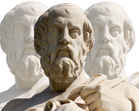Plato’s Theory of the Forms: A Response to the Third Man Argument
 What is the difference between myself and the desk at which I sit? Neither are anything but a simple assembly of atoms, floating about a universe of others. Where do I cease, in wake of something else? All possible distinctions made (though Parmenides and Zeno claimed these were not possible)[1] we are left still with the discombobulating question of what actually makes the desk before me what it is. How can we ascribe to two desks the same name despite their being comprised of different matters, fashioned into different shapes, and used in different ways? It would appear, from this standpoint, that the desks are entirely separate entities, unrelated in terms of anything we are able to observe objectively.
What is the difference between myself and the desk at which I sit? Neither are anything but a simple assembly of atoms, floating about a universe of others. Where do I cease, in wake of something else? All possible distinctions made (though Parmenides and Zeno claimed these were not possible)[1] we are left still with the discombobulating question of what actually makes the desk before me what it is. How can we ascribe to two desks the same name despite their being comprised of different matters, fashioned into different shapes, and used in different ways? It would appear, from this standpoint, that the desks are entirely separate entities, unrelated in terms of anything we are able to observe objectively.
But this surely cannot be the case. The wooden form before me is a table, and I—should I have instead been made up of wood and nails—would certainly not qualify as a table of any sort. But how are we able to make these judgements without a basis for their necessary distinctions? This has been dubbed the ‘problem of universals,’ which Plato alleged to resolve with his Theory of the Forms, first proffered in the Republic.
“The Platonic idealist,” said George Santayana, “is the man by nature so wedded to perfection that he sees in everything not the reality but the faultless ideal which the reality misses and suggests.”[2] Here Santayana was referring to the Theory of the Forms, or at least its employers (Plato’s philosopher-kings, for instance). The Theory of the Forms, in the way above described by Santayana, claims to deal with the problem of universals in providing a basis for our conceptual discrepancies.
Plato did, however, seem as willing to dissect his own theories as others were to scrutinise them.[3] In the Parmenides, described by twentieth-century philosopher Bertrand Russell as “one of the most remarkable cases in history of self-criticism,”[4] Plato refutes his own Theory of the Forms with a number of logical confutations. The Third Man Argument is perhaps the strongest among these, and an argument upon which for depth’s sake this essay will concentrate.
The aim of this essay is to defend the Theory of the Forms, and argue against the Third Man Argument’s criticisms—to effectively defend Plato from both himself and those who took up arms provided by the arguments posed by the Parmenides. In what follows I will present the Theory of the Forms, before moving on to explain the Third Man Argument as tendered by Plato’s self-evaluative works, concluding finally in how I believe the Third Man Argument relies on false premises and falls short of delivering a valid objection to the Forms.
I
Plato’s Theory of the Forms proposes that for every object or property in the world there is a perfect version, or Form, by virtue of which it is recognisable for what it is, and without which it would no longer be the sort of object or property we see it to be.[5] These Forms are immutable and absolute, and exist in a way very different to their instantiations, residing in “another dimension” as “ultimate reference points for all objects we observe in the physical world.”[6]
There is, for instance, a ‘Form’ for Beauty by virtue of which we recognise all its instantiations to be a part of the universal concept, despite how each one might exhibit the property in a different way. Many things can be said to possess beauty—a diamond, the sunrise, a piece of music—but none can be described as beauty itself in the way the Form of Beauty can. Beauty’s Form is that by which we are able to appreciate beautifulness as a whole, and is therefore vastly superior to any mere instance of beauty. Objects of the phenomenal world are partial to change and decay in a way that the Forms are not. They instead exist in an “abstract state,” separate from their instantiations and “independent of minds.”[7]
The Forms are necessarily perfect and immutable, and by definition paradigmatic of that which they constitute. They do not change and alter in the way of the physical world; for if they did they would no longer be perfect, and cease to be anything but yet another example of that which they truly are. Plato argued that “because the material world is changeable it is also unreliable,” and used this to build his conception of worthy knowledge coming only from an understanding of the Forms, and not their tangible instantiations. No one has, for example, drawn the perfect triangle, for the drawing of such a thing would require a level of precision the infinite reducibility of spatial measurements would render impossible. This does not, of course, mean that the perfect triangle does not exist: when we attempt to draw a triangle we are guided by our understanding of the Form of Triangle-ness, not of the imperfect demonstrations we have seen drawn before us.[8] The limits of the material world do not inhibit the Forms; the Forms are necessarily perfect, and the Form of Triangle-ness is perfectly triangular.
The Theory of the Forms offers a solution to the problem of universals by allowing a single object or property to partake in multiple Forms, even if one Form is contrary to another. By this conception it is possible for the Forms of Oneness and Plurality to coexist, for something to be both one and many without creating incongruity. To understand this one must first comprehend what is meant by ‘partaking.’ A particular object is not created in the image of a Form, as such; but rather partakes in the Forms that define its properties. An apple, for example, while partaking in the Form of Apple-ness, partakes also in the Forms of Redness, Food-ness, and even Solidness. This is to say that the object involves itself in the appropriate Forms in order to become the thing that it is. The Forms of Oneness and Plurality may coincide in the same way, as in how something may be both light and dark. A dimly-lit room, while partaking in the Form of Darkness (it may be darker than outside), partakes also in the Form of Lightness (for the room is lighter than, say, a cave’s interior).[9] This argument is described in the Parmenides by Plato’s portrayal of Socrates.
Oneness is but one of the many qualities Plato claims the Forms possess. Others, pulled from Plato’s texts, include uniqueness, separation, and being one-over-many.[10] The Parmenides utilises these qualities in its refutations, using them to support the view that the Theory of the Forms is self-contradictory. The Whole-Pie Argument, for instance, strikes confutation between the nature of oneness and the process of partaking, proposing them to be incompatible. The Third Man Argument, however, relies instead on presupposed properties of the Forms not explicitly featured in Plato’s dialogues but rather assumed from certain passage of the Phaedo[11]. The following section will explore the Third Man Argument, and outline its objection to the soundness of the Theory of the Forms.
|
Previous |
Works Cited
(All excerpts from Plato’s dialogues taken between December 19th and 22nd 2013 from: www.perseus.tufts.edu/cache/perscoll_Greco-Roman.html)
· Beck, M.C. (1999). Plato’s Self-corrective Development of the Concepts of Soul, Forms and Immortality in Three Arguments of the “Phaedo. Oxford: Clarendon Press.
· Cohen, S.. (2011). Readings in ancient Greek philosophy from Thales to Aristotle. In: Cohen, S. and Curd, P. Ancient Greek Philosophy . 4th ed. London: Hackett Publishing.
· Hales, S.D.. (1990). The Recurring Problem of the Third Man. Auslegung.
· Kraut, Richard, “Plato”, The Stanford Encyclopedia of Philosophy (Summer 2012 Edition), Edward N. Zalta (ed.), URL = <http://plato.stanford.edu/archives/sum2012/entries/plato/>
· Kung, J.. (1985). Aristotle on Thises, Suches and the Third Man Argument. Available: <www.stanford.edu/~mvr2j/sfsu12/reading/phil770_kung.pdf>. Last accessed 19/12/13.
· Lacewing, M.. (2007). Plato’s Theory of the Forms. Available: <cw.routledge.com/textbooks/alevelphilosophy/data/A2/Plato/PlatoTheoryForms.pdf>. Last accessed 19/12/13.
· Macintosh, D. . (2012). Plato: A Theory of Forms. Available: <philosophynow.org/issues/90/Plato_A_Theory_of_Forms>. Last accessed 19/12/13.
· Pelletier, F.J. and Zalta, E.N.. (2003). How to Say Goodbye to the Third Man. Available: <mally.stanford.edu/plato.pdf>. Last accessed 20/12/13.
· Rickless, S.. (2012). Plato’s Parmenides. Available: <plato.stanford.edu/entries/plato-parmenides/>. Last accessed 19/12/13.
· Russell, B. (1972). The History of Western Philosophy. New York: Touchstone.
· Saburns, D.. (2009). Does the Third Man Argument refute the theory of forms?. Available: <http://www3.sympatico.ca/saburns/pg0715e13.htm. Last accessed 19/12/13>.
· Sanday, E.C.. (2009). Eleatic Metaphysics in Plato’s Parmenides: Zeno’s Puzzle of Plurality. The Journal of Speculative Philosophy. 23 (3).
· Santayana, G. (2010). Egotism in German Philosophy. Charleston: Nabu Press.
· Sharma, R.. (2005). What is Aristotle’s “Third Man” Argument Against the Forms?. In: Sedley, D. Oxford Studies in Ancient Greek Philosophy. Oxford: Oxford University Press.
· Vlach, M. . (2012). Plato’s Theory of the Forms. Available: <www.theologicalstudies.org/resource-library/philosophy-dictionary/158-platos-theory-of-forms>. Last accessed 19/12/13.
· Watt, S.. (1997). Introduction: The Theory of Forms (Books 5-7). In: Plato: Republic. London: Wordsworth Editions.
[1] Sanday (2009) pp. 209-10
[2] Santayana (2010) pp. 16-7
[3] Watt (1997) pp. 14-6
[4] Russell (1972) pp. 127
[5] Kraut (2012)
[6] Vlach (2012)
[7] Lacewing (2007)
[8] Macintosh (2012)
[9] Cohen (2011) pp. 644
[10] Rickless (2012)
[11] Cohen (2011) pp. 307








